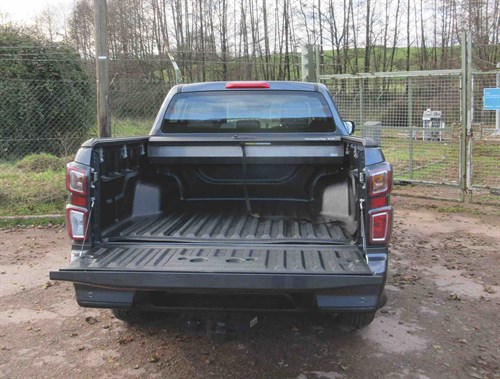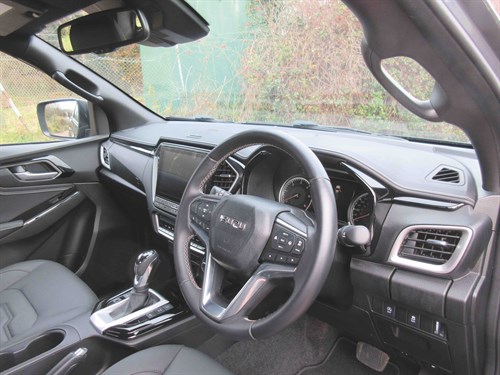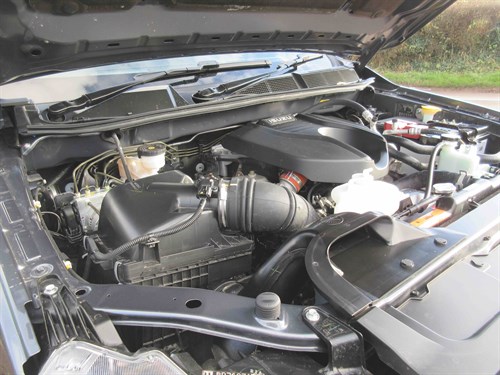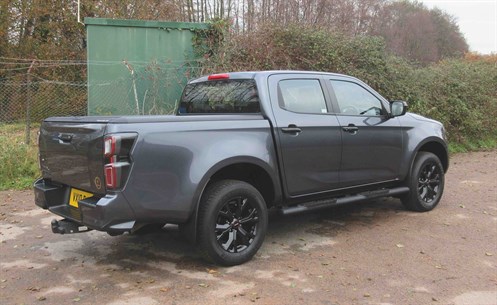There’s nothing wrong with giving an existing model a modest makeover and that is what Isuzu has done with its D-Max pick-up. The result was on display at last April’s Commercial Vehicle Show at Birmingham’s National Exhibition Centre, and surely nobody could take exception to the subtle changes.
The entire range is now graced by a redesigned front grille, and the All-Purpose and Adventure versions have been given new wheels too. New colours and upholstery changes have been introduced, and a rear differential lock is now listed as an option on manual 4×4 Utility variants.
Additionally, the D-Max line-up is impressively broad.
The entry-level Business range encompasses 4×2 and 4×4 single-cabs, 4×4 extended-cabs, and 4×4 double-cabs, all of which bear the Utility brand. Extended-cab and double-cab versions are offered with an automatic transmission as an alternative to the manual box.
The middle-ranking All-Purpose portfolio embraces extended-cab and double-cab 4×4 models with either a manual or an auto box and with the DL designation. That tells you that a diff lock is a standard feature.
The top-of-the-range Adventure line-up is somewhat narrower, consisting solely of the V-Cross double-cab in both manual and automatic guise.
Bear in mind that all extended and double-cab D-Max pick-ups weigh less than 2,040kg unladen. This means they’re subject to car rather than commercial vehicle speed limits, which gives them the edge over many rivals.
Goods vehicle limits are 10mph lower than car limits on single and dual-carriageways. As a consequence, D-Max can achieve better journey times than competitors while remaining legal.
No matter which D-Max you choose, you are faced with the same engine; a 1.9-litre 164hp diesel.
We got to grips with the V-Cross automatic four-door five-seater double cab. Here’s how we fared.

Load bay
Access to the cargo bay which can offer up to eight tie-down points is by means of a tailgate. Aided by a gas-filled strut on the offside, it drops down horizontally.
The load area is protected by a plastic liner which, in case the case of our test vehicle, was shielded by an optional – and by no means cheap – Mountain Top roll cover. This conceals anything you might happen to be carrying from bad weather and prying eyes, alike, and like the tailgate, it is lockable.

Interior and equipment
D-Max has a slightly old-fashioned-looking fascia, but is none the worse for that.
Buttons beneath the centrally-positioned 9in colour touchscreen control the heating, ventilation and air-conditioning, and that is something we welcome. Having to fiddle about with a screen for what seems like ages when all you want to do is boost the in-cab temperature a notch can be really irritating.
Buttons that are just above them allow you to switch the radio on and off and alter the volume, and they are to be welcomed too.
The screen controls the rest of the DAB radio’s functions, however, as part of a package that includes Bluetooth connectivity, Android Auto, and Apple CarPlay. If all you want is a quiet life then the display will show you a digital clock and a compass.
Further down the fascia you will find a 12v powerpoint, a USB socket, and the simple-to-use rotary switch that engages four-wheel drive. All you need to do is twist it once, then press it down and twist it again if you want four-wheel drive with a low-ratio set of gears.
Tap the transmission shift lever to the right and you can switch from auto to manual mode, to nip easily and quickly between gears. Buttons to engage the rear-diff lock and Hill Descent Control are positioned next to the lever.
In-cab storage includes a roomy lidded box between the front seats complemented by a pair of cup-holders, a lidded compartment on top of the dashboard, bins in all four doors, a shelf at the bottom of the dashboard, and a holder for your sunglasses just above the windscreen. For your money you get a lockable glovebox plus a lidded shelf above it that is home to a CD player.
To a what? Yes, you read that correctly – a CD player.
Some of the plastic trim looks a bit cheap and cheerful, and the all-black cab interior can feel a little gloomy, but on a more positive note, we’re happy to report that V-Cross boasts heated front seats. Leather upholstery is used throughout, and the steering wheel is leather trimmed.
Other handy facilities include front, side, curtain and driver’s knee airbags plus a centre airbag, electric windows all round, electrically adjustable, folding and heated exterior rear-view mirrors, cruise control and front foglamps. Good to see that the interior rear-view mirror has an automatic anti-glare function just in case the driver behind you forgets to dip his headlights at night.
A rear-view camera is fitted along with front and rear sensors to aid low-speed manoeuvring.
The position of the driver’s seat can be adjusted electrically in eight ways, including the height and angle of the cushion. The steering wheel, which features remote controls for the radio, is height-adjustable too, and can be adjusted for reach.
So far as the rear of the cab interior is concerned, the nearside and offside seats have adequate but not over-generous leg space. Whoever gets to sit on the middle seat will find both leg and shoulder room are severely constrained, however.
If the middle seat is empty then the back can be folded down and transformed into an armrest complete with a couple of cupholders; handy for the remaining passengers.
Ventilation for the rear passengers comes courtesy of vents in the back of the console between the two front seats which also plays host to a USB port. Capable of taking a maximum load of 4kg, a hook on the back of the front passenger seat can hold a substantial bagful of Friday night curry.
D-Max is so comprehensively equipped with onboard safety and driver assistance systems that it is difficult to know where to begin. Isuzu undoubtedly deserves top marks for the initiative it has taken in this area.
The package includes Adaptive Cruise Control; Forward Collision Warning; Autonomous Emergency Braking; Traffic Sign Recognition; Intelligent Speed Limiter; Lane Departure Warning and Prevention System; Lane Keep Assist; Pedal Misapplication Mitigation; Blind Spot Monitor; Emergency Lane Keeping; ABS; Brake Assist; Electronic Stability Control; Electronic Brakeforce Distribution; Hill Start Assist and Rear Cross Traffic Alert.
Describing what each of these devices does would take forever, but Rear Cross Traffic Alert is worth a special mention. Back out of a field and it will tell you if a vehicle you can’t see is coming, so you don’t reverse into its path.
Traction Control is installed, and can be switched off. Our D-Max was equipped with a tow bar plus the related electrics, so we were grateful for the presence of Trailer Sway Control, designed to prevent things getting out of shape if a trailer being towed starts to snake.
The headlights illuminate automatically at dusk and the windscreen wipers are triggered automatically if it rains.
Disc brakes are fitted at the front, while drums are employed for duty at the back. Our V-Cross’s 18in black chrome alloy wheels were shod with Dunlop Grand Trek AT25 255/60 R18 tyres.

Powertrain
Keyless ignition with a push-button start fires up the Isuzu’s four-cylinder turbocharged engine. Maximum power kicks in at 3,600rpm while torque of 360Nm bites across a 2,000rpm-to-2,500rpm plateau.
AdBlue is used to ensure the engine complies with the Euro 6 exhaust emission rules. The filler point for the 14-litre reservoir is located beneath a flap on the nearside of the body which also conceals the diesel refuelling inlet.
Driving
We’re getting so familiar with electronic parking brakes that reverting to a manual handbrake lever such as the one fitted to D-Max takes a bit of getting used to, and we had to be reminded to release it on at least a couple of occasions. Perhaps it is just as well then that acceleration from rest is not all that brisk.
Nor does the kick-down facility engage all that rapidly when you need to overtake. It is as though the engine is having to take a deep breath before pouring on the power required.
Put the engine under pressure and it can sound noisy and stressed. Show the truck an incline and you immediately drop down a gear, especially if you are heavily laden, and your momentum slows.
What we are saying here is that D-Max needs more power, especially if it is operating in hilly terrain and is being asked to haul a heavy trailer. While we readily concede that what is on offer at present will satisfy many businesses, Isuzu really needs to introduce a 200hp-or-thereabouts diesel as an option if it wants to stay abreast of
the competition.
If it does so, then more operators will be able to take advantage of the truck’s undoubted virtues. Unfortunately, there are no plans to provide D-Max with more beef.
Solidly constructed, it handles well, with none of the lurching and swaying into bends that might be expected from such a big truck. We were able to corner with confidence.
It rides well too even when lightly laden. If they have no weight in the back then many 4×4 pick-ups tend to hop about all over the place.
Grab handles on the A- and B-pillars give the cab’s occupants something to hang onto when the truck ventures off-road, and a lack of top-end power did not impede its non-stop progress through the mud.
Our demonstrator happily sloshed up and down squelchy slopes and trundled up and down heavily rutted rural tracks, casually shrugging off any and all obstacles it encountered. It crossed and recrossed streams brimming with icy water without hesitating, and willingly came back for more.
Just as well that there is plenty of underbody protection, including a steel guard for the engine sump, transmission and transfer case.

Operating
We’re pleased to see that a full-size spare wheel is provided, and the jack and tools can be found behind the rear seatback, which folds forward.
Service intervals are set at two years/12,000 miles, whichever comes first. While the mileage interval may seem a little short, that is no bad thing if the truck is being used extensively off-road, as damage which might otherwise remain undetected should be picked up and rectified.
Long-lasting LEDs are used in the headlights, daytime running lights, front foglamps, and rear lights.
An exemplary five-year/125,000-mile warranty protects D-Max, with a five-year UK and European roadside assistance package included for the duration. A 12-year anti-corrosion perforation warranty is present too.
You don’t buy a 4×4 double-cab pick-up if fuel economy is your top priority, although the presence of Stop & Start helps ensure that the damage to your wallet in this case isn’t as bad as it might otherwise be. We achieved an average of 28mpg, a bit below the claimed WLTP (Worldwide Harmonised Light Vehicle Test Procedure) combined figure of 30.7mpg.
Isuzu D-Max V-Cross automatic double-cab 4×4 pick-up
Price (ex VAT) £35,924
Price range (ex VAT) £23,924-£35,924
Gross payload 1090kg
Load length 1495mm
Load width (min/max) 1080mm/1530mm
Load bay height 490mm
Loading height 838mm
Gross vehicle weight 3100kg
Braked trailer towing weight 3500kg
Residual value 37.95%*
Cost per mile 80.3p
Engine size/power 1898cc, 164hp @ 3600rpm
Torque 360Nm @ 2000-2500rpm
Gearbox 6spd automatic
Fuel economy (combined WLTP) 30.7mpg
Fuel tank 76 litres
CO2 241g/km
Warranty 5yrs/125,000 miles
Service intervals 2yrs/12,000 miles
Insurance group 44D
Price as tested £38,709
* after 48 months @ 20,000 miles a year – source – KWIKcarcost
Options
Load bed roll cover £1,350
Black steel side bars and steps £375
Tow bar £275
13-pin electrics £185
Mica paint finish £600
Rivals
Ford Ranger/Ranger Raptor
Price range (ex VAT) £27,550-£49,300
Gross payload 652-1207kg
Braked towing weight 2500-3500kg
Engines 170hp, 205hp, 210hp 2.0 diesel, 240hp 3.0 diesel, 292hp 3.0 petrol
Verdict: While Ranger and Volkswagen’s Amarok are based on the same platform, Ranger covers a far wider sector of the market, with greater stress on entry-level specifications. Like all manufacturers, Ford harps on endlessly about battery-electric technology and zero-emissions, yet paradoxically seems perfectly relaxed about including a model with a V6 petrol engine with almost 300hp on tap in its pick-up line-up.
Toyota Hilux
Price range (ex VAT) £27,777-£60,187
Gross payload 1000-1030kg
Engines 150hp 2.4 diesel, 204hp 2.8 diesel
Verdict: The most important development Hilux has witnessed in recent times is the arrival of a 200hp-plus diesel which has given it a welcome power boost. The engine’s advent was accompanied by the arrival of a restyled exterior, an upgraded interior, and some useful mechanical changes. With a reputation for being well-nigh unbreakable, Hilux is not short of creature comforts. Second-hand values should be buoyant, and we like Toyota’s intelligent approach to warranty.
Volkswagen Amarok
Price range (ex VAT) £33,990-£48,410
Gross payload 842-1103kg
Braked towing weight 3420-3500kg
Engines 170hp, 205hp 2.0 diesel, 240hp 3.0 diesel
Verdict: Uses the same platform as Ford’s Ranger, but the styling is different, and Amarok is marketed solely as a 4×4 double cab. It is a well-thought-out package which builds on what the previous Amarok had to offer, and delivers plenty of improvements. As is usual with VW onboard safety is pitched at a high level, so is build quality, and the 10-speed automatic transmission delivers a commendably smooth change. Warranty and servicing package is impressive.
The Final Verdict
Design 9/10 – Well-put-together working tool which puts safety first.
Cabin 8/10 – Pleasant if slightly gloomy, well-equipped and with no shortage of storage.
Ride 8/10 – Surprisingly good no matter whether D-Max is laden or unladen.
Refinement 7/10 – Well-put-together with no squeaks or rattles, but noise sometimes an issue.
Load area 8/10 – Does exactly what it says on the tin.
Handling/performance 6/10 – Former is exemplary, latter is lacklustre because the truck needs more power.
Engine/transmission 8/10 – Horsepower lacking, but four-wheel-drive easy to engage.
Standard equipment 10/10 – Isuzu deserves high praise for building in so many safety devices.
Operating costs 7/10 – Decent warranty, but short service intervals and high fuel usage.
What Van? subjective rating 8/10 – Handy workhorse with lots of kit and a more than competent off-road performer.
Overall Rating = 79/100

